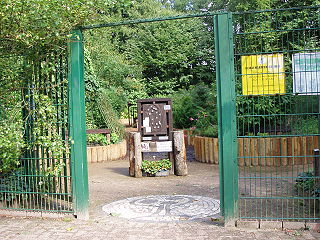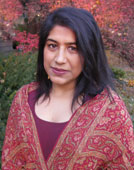
Perception is the organization, identification, and interpretation of sensory information in order to represent and understand the presented information or environment. All perception involves signals that go through the nervous system, which in turn result from physical or chemical stimulation of the sensory system. Vision involves light striking the retina of the eye; smell is mediated by odor molecules; and hearing involves pressure waves.

The sensory nervous system is a part of the nervous system responsible for processing sensory information. A sensory system consists of sensory neurons, neural pathways, and parts of the brain involved in sensory perception and interoception. Commonly recognized sensory systems are those for vision, hearing, touch, taste, smell, balance and visceral sensation. Sense organs are transducers that convert data from the outer physical world to the realm of the mind where people interpret the information, creating their perception of the world around them.

A sensorium (/sɛnˈsɔːrɪəm/) is the apparatus of an organism's perception considered as a whole, the "seat of sensation" where it experiences, perceives and interprets the environments within which it lives. The term originally entered English from the Late Latin in the mid-17th century, from the stem sens- ("sense"). In earlier use it referred, in a broader sense, to the brain as the mind's organ. In medical, psychological, and physiological discourse it has come to refer to the total character of the unique and changing sensory environments perceived by individuals. These include the sensation, perception, and interpretation of information about the world around us by using faculties of the mind such as senses, phenomenal and psychological perception, cognition, and intelligence.

A sensory garden is a self-contained garden area that allows visitors to enjoy a wide variety of sensory experiences. Sensory gardens are designed to provide opportunities to stimulate the senses, both individually and in combination, in ways that users may not usually encounter.
In medicine and anatomy, the special senses are the senses that have specialized organs devoted to them:
Sensory integration therapy (SIT) was originally developed by occupational therapist A. Jean Ayres in the 1970s to help children with sensory-processing difficulties. It was specifically designed to treat Sensory Processing Disorder. Sensory Integration Therapy is based on A. Jean Ayres's Sensory Integration Theory, which proposes that sensory-processing is linked to emotional regulation, learning, behavior, and participation in daily life. Sensory integration is the process of organizing sensations from the body and from environmental stimuli.

Alain Corbin (born January 12, 1936, in Courtomer is a French historian. He is a specialist of the 19th century in France and in microhistory.

The sense of smell, or olfaction, is the special sense through which smells are perceived. The sense of smell has many functions, including detecting desirable foods, hazards, and pheromones, and plays a role in taste.

Synesthesia or synaesthesia is a perceptual phenomenon in which stimulation of one sensory or cognitive pathway leads to involuntary experiences in a second sensory or cognitive pathway. For instance, people with synesthesia may experience colors when listening to music, see shapes when smelling certain scents, or perceive tastes when looking at words. People who report a lifelong history of such experiences are known as synesthetes. Awareness of synesthetic perceptions varies from person to person with the perception of synesthesia differing based on an individual's unique life experiences and the specific type of synesthesia that they have. In one common form of synesthesia, known as grapheme–color synesthesia or color–graphemic synesthesia, letters or numbers are perceived as inherently colored. In spatial-sequence, or number form synesthesia, numbers, months of the year, or days of the week elicit precise locations in space, or may appear as a three-dimensional map. Synesthetic associations can occur in any combination and any number of senses or cognitive pathways.
A sense is a biological system used by an organism for sensation, the process of gathering information about the world through the detection of stimuli. Although in some cultures five human senses were traditionally identified as such, many more are now recognized. Senses used by non-human organisms are even greater in variety and number. During sensation, sense organs collect various stimuli for transduction, meaning transformation into a form that can be understood by the brain. Sensation and perception are fundamental to nearly every aspect of an organism's cognition, behavior and thought.
Many types of sense loss occur due to a dysfunctional sensation process, whether it be ineffective receptors, nerve damage, or cerebral impairment. Unlike agnosia, these impairments are due to damages prior to the perception process.
Sensory design aims to establish an overall diagnosis of the sensory perceptions of a product, and define appropriate means to design or redesign it on that basis. It involves an observation of the diverse and varying situations in which a given product or object is used in order to measure the users' overall opinion of the product, its positive and negative aspects in terms of tactility, appearance, sound and so on.
Sensory branding is a type of marketing that appeals to all the senses in relation to the brand. It uses the senses to relate with customers on an emotional level. It is believed that the difference between an ordinary product and a captivating product is emotion. When emotion flows in the marketplace, your product shines. When there is no emotion from the product, customers lack the enthusiasm and passion that launches a product to success. Brands can forge emotional associations in the customers' minds by appealing to their senses. A multi-sensory brand experience generates certain beliefs, feelings, thoughts and opinions to create a brandgon image in the consumer's mind.

Aradhna Krishna is an American academic focused on marketing. As of 2006, she was considered one of the 50 most productive marketing professors in the world. Harvard Business Review recently acknowledged her as "the foremost expert in the field" of sensory marketing. She is the Dwight F. Benton Professor of Marketing at the Ross School of Business at the University of Michigan. She was awarded as a fellow of the Society for Consumer Psychology, the organization's highest honor, in recognition of her contributions to consumer psychology.
Most fish possess highly developed sense organs. Nearly all daylight fish have color vision that is at least as good as a human's. Many fish also have chemoreceptors that are responsible for extraordinary senses of taste and smell. Although they have ears, many fish may not hear very well. Most fish have sensitive receptors that form the lateral line system, which detects gentle currents and vibrations, and senses the motion of nearby fish and prey. Sharks can sense frequencies in the range of 25 to 50 Hz through their lateral line.
Psychosensory therapy is a form of therapeutic treatment that uses sensory stimuli to affect psychological and emotional health. In addition, psychosensory therapy is a group of therapeutic techniques that involves applying sensory inputs to treat various behaviors, mood, thoughts, symptoms, and pain. Psychosensory therapy has its roots in traditional Chinese medicine in addition to energy psychology. Some important figures in psychosensory therapy include chiropractor George Goodheart, psychiatrist John Diamond, clinical psychologist Roger Callahan, and Ronald Ruden.
Sensobiographic walking is an ethnographic research method. It provides a possibility for the study of rich, embodied and site-specific emergence of sensory remembering and experiences.
Sensory tourism is a form of tourism, that caters for people with vision impairment. Those suffering from vision impairment face many difficulties based around mainstream tourism such as access to information, navigation, safety and the knowledge of others around them. This has caused the visionless members of society to travel much less than those with no vision impairment. Combining the theories behind tourism in terms of its psychology and its relation to the senses, an inclusive experience for the visually disabled was developed. Sensory tourism engages the physical and multi-sensory aspects of tourism, enhancing the tourism experience specifically for those with, but also benefitting those without vision impairment.
Olfactory heritage is an aspect of cultural heritage concerning smells that are meaningful to a community due to their connections with significant places, practices, objects or traditions, and can therefore be considered part of the cultural legacy for future generations.

Olfactic communication is a channel of nonverbal communication referring to the various ways people and animals communicate and engage in social interaction through their sense of smell. Our human olfactory sense is one of the most phylogenetically primitive and emotionally intimate of the five senses; the sensation of smell is thought to be the most matured and developed human sense.









